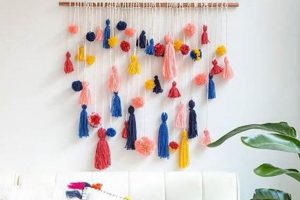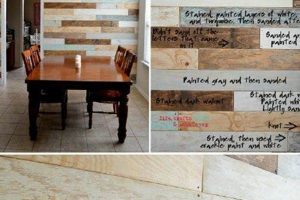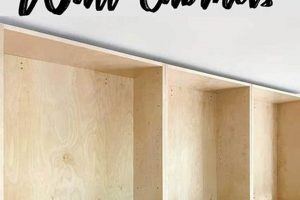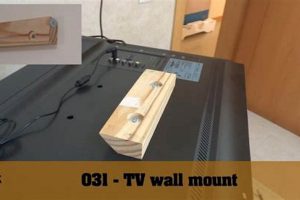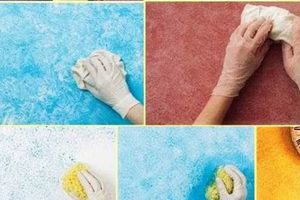A self-constructed vertical water feature allows individuals to introduce the calming presence of flowing water into interior or exterior spaces. These projects involve creating a structure, typically a wall or panel, over which water is pumped and recirculated, providing both visual and auditory appeal. A common example involves utilizing a framed sheet of acrylic or glass as the backdrop, with water cascading down its surface into a basin hidden below.
Incorporating such a feature into a home or garden can provide several advantages. The sound of flowing water can mask unwanted background noise, contributing to a more tranquil environment. Furthermore, these features can increase humidity levels, which may be beneficial in dry climates. Historically, water features have been used in gardens and landscapes across various cultures to symbolize prosperity, purity, and well-being, suggesting a deeply rooted human connection to the element of water.
The following sections will explore various aspects involved in constructing a vertical water feature, including material selection, pump considerations, structural support, and long-term maintenance practices. Careful planning and execution are essential to ensure a successful and aesthetically pleasing outcome.
Essential Construction Guidance
The successful integration of a self-constructed vertical water feature necessitates adherence to specific guidelines. Prioritizing safety and structural integrity throughout the construction process is paramount.
Tip 1: Material Compatibility. Verify the chemical compatibility of all materials utilized in the water circulation system. Certain plastics and metals may leach harmful substances into the water, potentially impacting its quality and promoting algae growth.
Tip 2: Pump Selection. Calculate the necessary flow rate based on the feature’s dimensions and design. Oversized pumps consume excessive energy, while undersized pumps fail to deliver the desired visual effect. Prioritize submersible pumps designed for continuous operation.
Tip 3: Waterproofing Integrity. Apply multiple coats of waterproofing sealant to all surfaces in contact with water. Focus on seams and joints, which are prone to leakage. Conduct a thorough water test before completing the installation.
Tip 4: Filtration Implementation. Incorporate a filtration system to remove debris and prevent pump clogging. Consider mechanical filtration (e.g., sponges) and biological filtration (e.g., ceramic media) to maintain water clarity.
Tip 5: Electrical Safety. Ensure all electrical connections are grounded and protected by a Ground Fault Circuit Interrupter (GFCI). Route electrical wiring away from water sources to minimize the risk of electric shock.
Tip 6: Structural Support. Reinforce the supporting structure to withstand the weight of the water and materials. Consider using pressure-treated lumber or metal framing for increased durability. Securely anchor the feature to prevent tipping or collapse.
Tip 7: Algae Control. Implement strategies to mitigate algae growth, such as utilizing UV sterilizers or introducing algaecides formulated for aquatic environments. Regular cleaning and water changes are also essential.
Adherence to these guidelines minimizes the risk of structural failures, water damage, and potential health hazards. A well-constructed feature provides long-lasting aesthetic enjoyment and promotes a tranquil environment.
The following section will address ongoing maintenance procedures to ensure the continued functionality and visual appeal of the vertical water feature.
1. Structural Integrity
Structural integrity represents a foundational element in the successful creation and long-term operation of a self-constructed vertical water feature. It directly influences the stability and safety of the entire assembly, mitigating risks associated with potential collapse or failure. The considerable weight of water, combined with the weight of the supporting materials, exerts substantial force on the structure. Insufficient structural design or inadequate materials can lead to catastrophic results, including water damage to surrounding areas and potential injury to individuals. For instance, a water feature constructed with inadequately sized lumber may buckle under the accumulated weight, resulting in a sudden and uncontrolled release of water.
The practical significance of understanding and implementing sound structural principles extends beyond mere safety considerations. A structurally sound feature requires less frequent repairs and maintenance, reducing the overall cost of ownership. Furthermore, proper structural design allows for greater design flexibility, enabling the incorporation of more intricate and aesthetically pleasing elements. An example of this is a larger scale feature that incorporates natural stone elements. These heavier materials necessitate a robust framework capable of supporting the additional load. Failure to account for this added weight during the design phase can lead to premature structural fatigue and eventual failure.
In summary, structural integrity is not merely an ancillary consideration but an indispensable component of any self-constructed vertical water feature. Robust design and appropriate material selection directly contribute to the safety, longevity, and aesthetic potential of the installation. Neglecting this crucial aspect can result in costly repairs, potential hazards, and ultimately, the premature failure of the entire project. Therefore, a thorough understanding of structural principles is essential for anyone undertaking the construction of such a feature.
2. Waterproofing Method
The selection and implementation of a robust waterproofing method are critical to the success of any self-constructed vertical water feature. This process directly prevents water damage to surrounding structures and ensures the long-term viability of the installation. The interconnectedness of the waterproofing method and the feature is a direct cause-and-effect relationship; ineffective waterproofing will inevitably lead to leaks, moisture damage, and potential structural compromise. Without effective barriers, water can seep into walls, floors, and adjacent areas, fostering mold growth, wood rot, and costly repairs. The importance of the waterproofing method is amplified by the continuous water recirculation inherent in such features.
The practical application of waterproofing involves several considerations. The choice of sealant or membrane must be compatible with the materials used in the feature’s construction. For example, using an inappropriate sealant on concrete can result in its degradation and eventual failure. Furthermore, proper surface preparation is essential. Surfaces must be clean, dry, and free of debris before applying any waterproofing agent. Multiple coats are typically required to ensure complete coverage and eliminate weak points. A common strategy involves using a liquid rubber membrane followed by a protective layer of sealant to prolong the waterproof barrier’s integrity. Careful attention to detail, particularly around joints and seams, is paramount to prevent water infiltration.
Ultimately, the waterproofing method is not an optional add-on but an integral component of a functional and durable vertical water feature. The challenges associated with inadequate waterproofing underscore the importance of meticulous planning and execution. Failure to address this aspect effectively can lead to significant problems, negating the aesthetic benefits and resulting in costly remediation. A thorough understanding of available waterproofing technologies and their proper application is, therefore, crucial for anyone undertaking the construction of a such feature.
3. Pump Capacity
Pump capacity represents a critical determinant in the operational effectiveness and visual appeal of a self-constructed vertical water feature. The flow rate, measured in gallons per hour (GPH) or liters per hour (LPH), directly dictates the volume of water circulating through the system. Insufficient pump capacity results in a weak, underwhelming flow, undermining the intended aesthetic impact. Conversely, excessive pump capacity leads to over-splashing, noise pollution, and unnecessary energy consumption. Therefore, selecting a pump with appropriate capacity is essential for achieving the desired balance between visual effect and operational efficiency. An example illustrates this point: a wall feature spanning six feet in width requires a significantly higher flow rate than a similar feature measuring only two feet, necessitating careful calculation of the required pump capacity.
The determination of appropriate pump capacity requires consideration of several factors beyond the physical dimensions of the feature. The height to which water must be lifted, often referred to as “head height,” significantly impacts pump performance. As head height increases, the actual flow rate delivered by the pump decreases. Additionally, the complexity of the water distribution system, including the number of nozzles or outlets, influences the necessary pump capacity. A distribution system with multiple small outlets requires a higher pressure and flow rate than a system with a single, larger outlet. Practical application of this understanding involves consulting pump performance curves, typically provided by the manufacturer, which illustrate the relationship between head height and flow rate. These curves allow for precise pump selection based on the specific parameters of the water feature.
In summary, pump capacity is inextricably linked to the overall success of a self-constructed vertical water feature. Accurate calculation and appropriate pump selection are paramount to achieving the desired visual effect, minimizing operational inefficiencies, and ensuring the long-term reliability of the system. The challenges associated with incorrect pump sizing underscore the importance of thorough planning and a comprehensive understanding of hydraulic principles. Neglecting this critical aspect can lead to diminished aesthetic appeal, increased energy costs, and potential pump failure, ultimately compromising the entire project. Therefore, pump capacity should be regarded as a fundamental design consideration, rather than a secondary afterthought.
4. Filtration System
In the context of a self-constructed vertical water feature, a filtration system serves as an indispensable element, directly impacting water clarity, system longevity, and the overall aesthetic appeal. The primary function of a filtration system is to remove particulate matter, organic debris, and other contaminants from the recirculating water, preventing cloudiness, algae growth, and potential damage to the pump. Without an effective filtration system, the water within the feature will rapidly deteriorate, diminishing its visual appeal and potentially requiring frequent and costly maintenance.
- Mechanical Filtration
Mechanical filtration involves the physical removal of suspended solids from the water. This is typically achieved through the use of filter sponges, filter floss, or similar materials that trap debris as water passes through them. Examples include using porous foam pads to capture leaves, sediment, and other visible particles. Regular cleaning or replacement of these mechanical filters is essential to maintain their effectiveness and prevent clogging, which can reduce water flow and strain the pump.
- Biological Filtration
Biological filtration utilizes beneficial bacteria to break down dissolved organic waste products, such as ammonia and nitrites, which are toxic to aquatic life and contribute to algae growth. This is commonly accomplished by providing a porous surface, such as ceramic rings or bio-balls, for bacteria to colonize. The bacteria convert these harmful substances into less toxic nitrates. Proper biological filtration is critical for maintaining water quality and preventing the buildup of undesirable chemicals within the vertical water feature.
- Chemical Filtration
Chemical filtration involves the use of substances that absorb or react with specific contaminants in the water. Activated carbon is a common chemical filtration medium that removes chlorine, tannins, and other organic compounds that can discolor the water or create unpleasant odors. Zeolite is another example, used to remove ammonia. Chemical filtration can improve water clarity and overall water quality, but it is typically used in conjunction with mechanical and biological filtration for optimal results.
- UV Sterilization
UV sterilization utilizes ultraviolet light to kill algae, bacteria, and other microorganisms in the water. A UV sterilizer consists of a UV lamp enclosed in a protective sleeve, through which water is passed. Exposure to UV light disrupts the DNA of these organisms, preventing them from reproducing and effectively sterilizing the water. UV sterilization can significantly reduce algae blooms and improve water clarity, but it does not remove particulate matter or dissolved organic waste, making it most effective when used in conjunction with mechanical and biological filtration.
The selection and implementation of an appropriate filtration system are crucial for the sustained health and aesthetic quality of a self-constructed vertical water feature. By integrating mechanical, biological, and potentially chemical filtration or UV sterilization, it is possible to maintain crystal-clear water, minimize maintenance requirements, and create a visually appealing and ecologically balanced environment. The interplay of these filtration methods provides a comprehensive approach to water purification, ensuring that the feature remains a source of visual enjoyment for years to come.
5. Material Selection
Material selection represents a cornerstone in the successful design and construction of a self-constructed vertical water feature. The choice of materials directly influences the structural integrity, aesthetic appeal, and long-term durability of the installation. Careful consideration of factors such as water resistance, weight, compatibility, and aesthetic properties is paramount.
- Water Resistance and Durability
Materials utilized in a vertical water feature must exhibit exceptional resistance to water damage and degradation. Untreated wood, for example, is susceptible to rot and decay when exposed to constant moisture. Suitable materials include certain plastics, stainless steel, sealed concrete, and treated lumber rated for prolonged water submersion. The selection of these materials mitigates the risk of structural failure and extends the lifespan of the feature.
- Weight Considerations
The combined weight of the water, structural components, and decorative elements places significant stress on the supporting structure. Heavy materials, such as natural stone or thick glass panels, require robust framing to prevent collapse. Lightweight alternatives, such as acrylic or fiberglass, reduce the overall load but may compromise the desired aesthetic. Careful calculation of the total weight is essential for ensuring structural stability and preventing potential hazards.
- Material Compatibility
The chemical compatibility of materials in contact with water is a crucial consideration. Certain metals, such as copper and untreated steel, can corrode and leach harmful substances into the water, affecting water quality and potentially damaging the pump. Similarly, some plastics may release chemicals that promote algae growth. Selecting materials that are chemically inert and compatible with aquatic environments is essential for maintaining water purity and preventing system malfunctions.
- Aesthetic Properties
The choice of materials significantly influences the visual appeal of the vertical water feature. Natural stone provides a rustic and organic aesthetic, while glass or acrylic offers a sleek and modern look. Consideration should be given to the texture, color, and overall design of the materials to complement the surrounding environment. An example would be selecting dark slate to contrast with bright greenery or opting for a translucent acrylic panel to allow for backlighting effects.
The interplay of these factors emphasizes the importance of a holistic approach to material selection for a self-constructed vertical water feature. A balanced consideration of water resistance, weight, compatibility, and aesthetic properties ensures a durable, visually appealing, and long-lasting installation. Neglecting any of these aspects can compromise the integrity and overall success of the project. Thorough research and careful planning are essential for making informed decisions regarding material selection and achieving the desired outcome.
Frequently Asked Questions
The following questions address common concerns and misconceptions regarding the construction and maintenance of self-constructed vertical water features. Accurate information is essential for successful project completion and long-term operational efficiency.
Question 1: What are the fundamental structural considerations when constructing a vertical water feature?
Structural integrity is paramount. The supporting framework must withstand the combined weight of water, materials, and any decorative elements. Pressure-treated lumber, reinforced metal frames, or similar robust materials are essential. Proper anchoring to a stable surface is also critical to prevent tipping or collapse.
Question 2: What waterproofing methods are most effective for preventing leaks and water damage?
Multiple layers of waterproofing are recommended. Liquid rubber membranes, epoxy sealants, or specialized waterproof coatings designed for aquatic environments are suitable options. Seams and joints require particular attention and should be thoroughly sealed. Regular inspection and maintenance are crucial for long-term leak prevention.
Question 3: How is the appropriate pump capacity determined for a vertical water feature?
Pump capacity is determined by the feature’s dimensions, height, and desired flow rate. Calculate the total volume of water to be circulated and select a pump with a gallons-per-hour (GPH) rating that meets or slightly exceeds this requirement. Account for head height, which reduces pump performance. Consulting pump performance curves is recommended for accurate selection.
Question 4: What type of filtration system is necessary for maintaining water clarity and preventing algae growth?
A multi-stage filtration system is recommended, incorporating mechanical, biological, and potentially chemical filtration. Mechanical filtration removes particulate matter, biological filtration breaks down organic waste, and chemical filtration removes specific contaminants. Regular cleaning or replacement of filter media is essential. UV sterilizers can also be used to control algae growth.
Question 5: What materials are suitable for use in a vertical water feature to prevent corrosion or contamination?
Materials must be water-resistant, chemically inert, and non-toxic. Suitable options include stainless steel, certain plastics, sealed concrete, and treated lumber. Avoid using copper, untreated steel, or materials that may leach harmful substances into the water.
Question 6: What are the key maintenance tasks required to ensure the long-term functionality and aesthetic appeal of a vertical water feature?
Regular maintenance includes cleaning or replacing filter media, inspecting and maintaining the pump, checking for leaks, and controlling algae growth. Periodic water changes may also be necessary to maintain water quality. Inspecting the structure for signs of wear or damage and addressing any issues promptly is also crucial.
Careful planning, appropriate material selection, and consistent maintenance are crucial for the success of a self-constructed vertical water feature. Adhering to these principles will promote both longevity and a pleasing aesthetic.
The subsequent section will discuss advanced design techniques for enhanced visual impact.
Conclusion
The preceding analysis has explored various critical aspects of constructing a diy waterfall wall, emphasizing the importance of structural integrity, effective waterproofing, appropriate pump selection, comprehensive filtration, and careful material selection. Each of these elements contributes significantly to the functionality, longevity, and aesthetic appeal of the final installation. A thorough understanding of these principles is essential for successful project execution and mitigating potential issues associated with water damage, structural instability, and diminished water quality.
The creation of a vertical water feature represents a significant undertaking that demands both technical proficiency and meticulous planning. By adhering to the guidelines presented, individuals can transform their living spaces with a tranquil and visually compelling addition. Future advancements in materials and technology may further enhance the accessibility and sophistication of these projects, promoting greater integration of natural elements into architectural design. It is imperative that all construction adhere to local building codes and safety regulations to ensure a secure and compliant installation.


